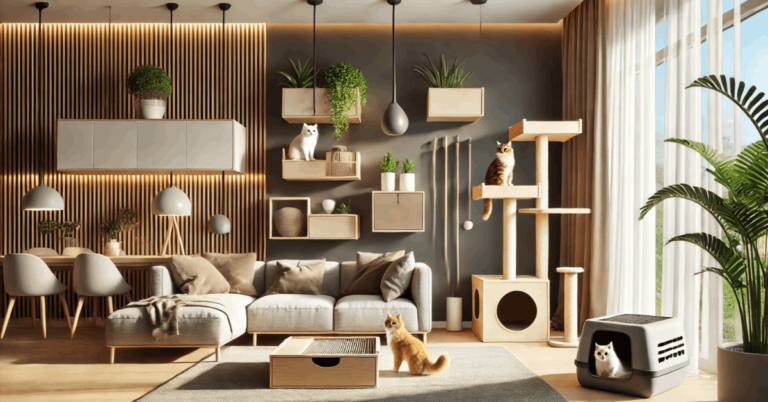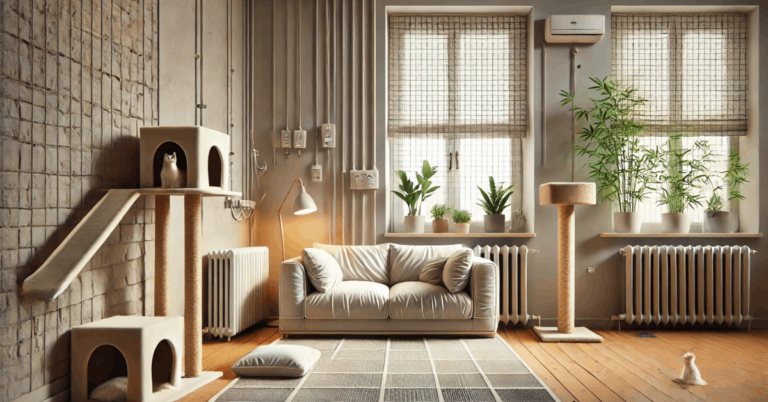Keeping cats active helps maintain a healthy weight, as obesity affects over 60% of cats globally.
Adding cat trees, climbing areas, and platforms encourages exercise and strengthens muscles.
Toys or wands can motivate climbing, jumping, and pouncing while supporting natural behaviors like scratching and exploring.
Functional spaces keep cats mentally stimulated and improve their overall well-being.
Purrfect Perches for Cats
Designing a cat-friendly home involves providing elevated spaces for climbing, lounging, and observing their surroundings.
Cats naturally enjoy high vantage points, which help them feel secure and content.
Install sturdy shelves, multi-level cat trees, or wall-mounted perches to create vertical spaces for your cat to enjoy. These additions can suit homes of various sizes and styles worldwide.
Scratch-Friendly Zones
A cat-friendly home should include designated areas for scratching. Scratching allows cats to stretch, mark territory, and maintain healthy claws.
Introduce durable scratching posts, boards, or pads in key areas of your home.
Consider materials like sisal or cardboard that appeal to cats. These solutions help protect furniture while meeting your cat’s instincts.
Style Tip 1: Creating a Cat-Friendly Home Layout
Designing a home that meets your cat’s needs while maintaining style is essential for creating a harmonious space. Focus on making the environment safe, comfortable, and engaging for cats worldwide.
Secure Resting Spots
Cats need quiet, cozy spaces to relax and feel safe. Incorporate secure resting spots throughout your home, such as:
- Enclosed cat beds or igloos.
- Plush blankets in tucked-away corners.
- Small spaces like shelves or under furniture for privacy.
These areas provide comfort and security, essential for their well-being.
Activity Areas for Play
Active cats are happy cats. Ensure your home includes open spaces where they can play and explore. Consider adding:
- Interactive toys like laser pointers and feather wands.
- Cat tunnels for running and hiding.
- Open areas for free movement and play sessions.
Play zones support physical health and prevent boredom, making your home enjoyable for your feline.
Safe Hiding Spots
Cats need quiet zones to retreat when feeling stressed. Set up hiding spots around the home, such as:
- Covered boxes or beds for secure escapes.
- Elevated perches for observation and safety.
- Calm, quiet rooms where they can relax undisturbed.
These zones help reduce anxiety and ensure they feel protected.
Style Tip 2: Whisker-Worthy Window Views for Cats
Create engaging and cozy spaces to keep your cat entertained and happy.
Bird-Watching Stations
Cats love observing movement, especially birds. Setting up a bird-watching station near a window adds both entertainment and enrichment.
Install a bird feeder outside a secure window to attract birds. This setup allows cats to enjoy hours of stimulation without risk, ensuring their safety indoors.
Window Hammocks
Window hammocks attached using strong suction cups offer an elevated, sunny spot for cats to relax.
These hammocks utilize vertical space effectively and provide a comfortable alternative to furniture lounging. They are an ideal addition for cats who enjoy basking in natural light.
Cat-Safe Plants
Enhancing window areas with cat-safe greenery improves aesthetics and provides enrichment.
Options like spider plants, Boston ferns, and cat grass are visually pleasing and safe for cats. Avoid toxic plants such as lilies and poinsettias to ensure your cat’s safety.
Style Tip 3: Stylish Additions for a Cat-Friendly Home
Add practical and aesthetic touches to create a harmonious space for you and your cat.
- Coordinated Toys: Incorporating toys that match home decor keeps the environment stylish and functional. Selecting toys in colors or designs that blend with furniture ensures a cohesive look while maintaining easy cat entertainment access.
- Cat-Themed Art: Adding cat-themed art enhances a home’s character while reflecting love for cats. Options range from playful portraits to modern feline-inspired designs. This decor element appeals to worldwide cat lovers seeking to personalize their living spaces.
- Custom Name Plaques: Custom name plaques elevate a cat’s designated space, creating a special area in the home. Wooden or engraved metal designs add charm while highlighting the cat’s unique identity, giving them a VIP presence.
How To Welcome Your Purr Friend to Your Purr-Friendly Home?
Bringing a new cat into your home requires a focus on creating a comfortable and functional space that caters to their needs.
Use these tips to ensure a smooth transition and establish an environment where your cat feels secure and happy.
1. Create a Safe Space
Designate a quiet, private room for your cat to acclimate to their new surroundings. This area should include:
- A cozy, eco-friendly cat bed.
- Food and water bowls.
- A litter box with accessible placement.
- Interactive toys for mental stimulation.
A separate space allows cats to feel secure while gradually adjusting to the household.
2. Gather Key Supplies
Ensure your home has essential items to support your cat’s comfort and well-being:
- High-quality cat food tailored to their age and health.
- A litter box and appropriate litter.
- Scratching posts and climbing structures.
- A secure carrier for travel needs.
3. Initial Arrival
When bringing a new cat into your home, gently place them in the prepared safe space. Allow them to explore without interference. Key actions include:
- Avoid overwhelming them with affection initially.
- Allowing them to sniff and investigate their surroundings freely.
- Maintaining a quiet environment to help them feel at ease.
This period helps your cat adjust without unnecessary stress.
4. Gradual Introduction to Family Members
Once your cat is comfortable in their safe space, introduce them to family members, including other pets, carefully:
- Family members should observe quietly from a distance initially.
- Encourage gentle, non-intrusive interactions.
- Monitor existing pets’ reactions and provide them with reassurance and attention.
This gradual process reduces anxiety for both the new and existing pets.
5. Introducing Your Cat to Existing Pets
Cats are territorial, so integrating them with other pets requires patience and planning.
Supervised Interactions:
- Use a barrier, such as a baby gate, for visual introductions without direct contact.
- Watch for stress signals like hissing, growling, or retreating.
- Gradually extend the duration of these interactions as comfort increases.
Fostering Positive Interactions:
- Use treats to create positive associations during meetings.
- Engage them in parallel play with separate toys.
- Rotate individual bonding times to ensure all pets feel included.
6. The Role of a Comfortable, Sustainable Bed
Cats spend much of their time sleeping, so making a cozy and eco-friendly bed is essential for their comfort and well-being. Benefits of a sustainable cat bed include:
- Improved sleep quality, supporting overall health.
- Encouragement of natural behaviors like curling up and stretching.
- Reduced environmental impact through the use of eco-friendly materials.
Place the bed in a quiet, secure location to give your cat a safe retreat.
7. Observing Behavior and Reducing Stress
Monitor your cat’s behavior during their adjustment period. Everyday stress signals include:
- Excessive hiding.
- Aggression toward family members or pets.
- Changes in eating or litter box habits.
If stress signs appear, provide extra time for your cat to adjust. Seek advice from a veterinarian or animal behaviorist if needed.
Conclusion
Creating a cat-friendly home means combining functionality and style to ensure you and your cat can enjoy the space.
Focus on vertical climbing areas, cozy resting spots, and scratching surfaces to protect furniture. Prioritize features that cater to natural feline behaviors, making your home a comfortable environment for your cat.
A well-thought-out cat-friendly design benefits both the pet and the owner, creating a harmonious living space.


